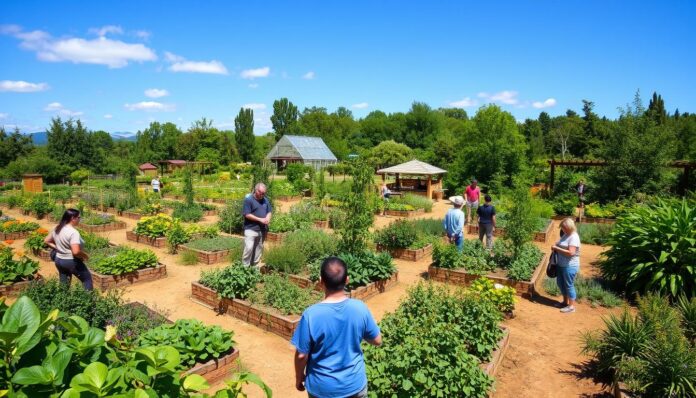Imagine creating a travel experience that teaches visitors about saving the environment and living sustainably. This is what permaculture tourism is all about. It’s a chance to offer tours that are both fun and educational. With more people wanting to live sustainably, permaculture tourism is becoming a hit.
You can make engaging activities for tourists by using permaculture. This way, you help protect nature and preserve culture. You can build sustainable landscapes and offer eco-friendly places to stay. So, how do you start your own permaculture tourism business?
Key Takeaways
- Permaculture tourist activities offer a unique opportunity to promote eco-friendly tours and sustainable travel experiences.
- Applying permaculture principles can help create engaging tourist activities that contribute to environmental conservation and sustainable living.
- Sustainable travel experiences can be achieved through the creation of sustainable landscapes and incorporation of eco-friendly accommodations.
- Permaculture tourism has the potential to reduce waste and promote closed-loop systems, leading to a more sustainable future.
- Understanding local climate patterns and incorporating renewable energy sources is crucial in designing successful permaculture systems.
- Permaculture tourism can contribute to the preservation of natural environments and cultural heritage, making it a valuable investment for the future.
Understanding Permaculture
Permaculture is a way to design ecosystems that work on their own. It’s about living in harmony with nature, not just gardening. This philosophy can be used in many areas, making travel more sustainable by offering organic farming excursions and nature-based adventures.
Learning about permaculture helps us appreciate nature more. It teaches us to live in harmony with the environment. This knowledge can be used in gardens or community projects, leading to a greener lifestyle.
- Designing sustainable ecosystems
- Promoting biodiversity
- Conserving natural resources
- Supporting local communities
By following permaculture, we can help make the future more sustainable. It’s about caring for both people and the planet. Through organic farming excursions or nature-based adventures, permaculture lets us connect with nature and support eco-friendly living.
| Permaculture Principles | Description |
|---|---|
| Observe and Interact | Observe the natural world and interact with it in a way that promotes sustainability |
| Catch and Store Energy | Catch and store energy from natural sources, such as sunlight and rainwater |
| Obtain a Yield | Obtain a yield from the natural world, while promoting sustainability and conservation |
Implementing Permaculture in Tourism
Permaculture can make tourist spots unique and green. It helps the environment and local people. Visitors can learn about organic farming and conservation.
Some examples of regenerative tourism activities include:
- Participating in community-supported agriculture (CSA) programs
- Engaging in conservation efforts, such as tree planting and wildlife conservation
- Learning about permaculture principles and practices through workshops and educational programs
These activities give tourists a special and enriching experience. They also help the local economy and support sustainable growth. By choosing these activities, visitors can make a positive difference and have a great trip.
The need for green tourism is rising. Using permaculture in tourist activities is key. It attracts travelers who care about the planet and supports a sustainable tourism future.
| Regenerative Tourism Activities | Benefits |
|---|---|
| Organic farming | Promotes biodiversity, improves soil health, and supports local economies |
| Conservation efforts | Protects wildlife, preserves ecosystems, and enhances ecosystem services |
| Permaculture workshops | Educates tourists about sustainable practices, promotes cultural exchange, and supports local communities |
Educational Aspects of Permaculture Tourism
Permaculture tourism lets visitors learn about the environment through unique experiences. They can join workshops and activities to understand permaculture. This way, they see how it works in sustainable tourism.
Visitors can take guided tours of permaculture farms. They learn about farming that’s good for the planet and saves biodiversity. They can also stay in eco-friendly places. This lets them see how to live in a way that’s kind to the earth.
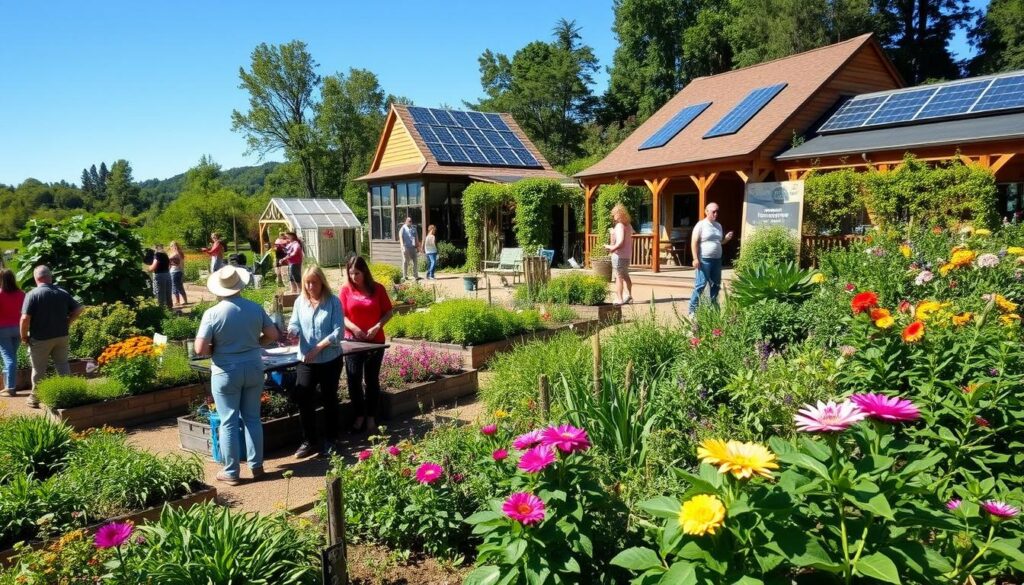
Permaculture tourism is also a chance for communities to share their knowledge. It helps with cultural exchange and protecting the environment. By choosing local products and supporting local economies, tourists help make tourism more sustainable.
Some of the key benefits of permaculture tourism include:
- Promoting environmental conservation and sustainability
- Supporting local economies and communities
- Providing unique and engaging educational experiences for visitors
Permaculture tourism is a special way for visitors to learn and travel sustainably. It helps them understand permaculture and how it makes tourism better for the planet.
Community Involvement and Permaculture
Community involvement is key in permaculture. It builds a sense of belonging and teamwork. By supporting local economies and cultural exchange, permaculture activities help the community. For instance, permaculture practices can help create community gardens. These gardens are places where people can gather and learn about living sustainably.
Some benefits of community involvement in permaculture include:
- Supporting local economies through buying local products and services
- Promoting cultural exchange by sharing knowledge and traditions
- Building a sense of community and teamwork among members
Eco-friendly tours also help by letting visitors learn and join in permaculture activities. They might help at a community garden or take part in a workshop on sustainable living.
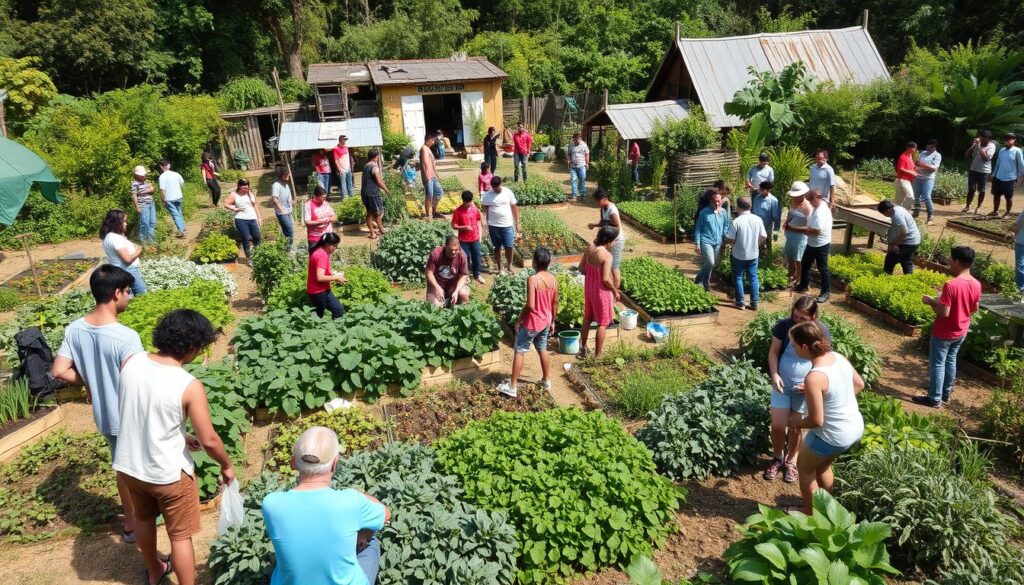
Using permaculture in community development can lead to thriving, sustainable places. This is done by applying permaculture design principles like zone planning and guilds. These help create a complete and connected system.
| Community Garden Plot Rental | Cost |
|---|---|
| 1 plot | $36 per year |
| 2 plots | $72 per year |
| 3 plots | $108 per year |
Challenges and Opportunities in Permaculture Tourism
Permaculture tourism combines sustainable travel and organic farming excursions. It attracts many who care about the environment. A study found that about 50% of tourists want to travel sustainably.
Most travelers, 76%, prefer places that are eco-friendly. Permaculture tourism creates more jobs than traditional farming. A study showed that permaculture sites make customers happier than regular tourist spots.
Practitioners face challenges due to social structures and attitudes. Yet, research links permaculture to helping achieve Zero Hunger. For more on permaculture’s impact, check out this study on Southern Africa.
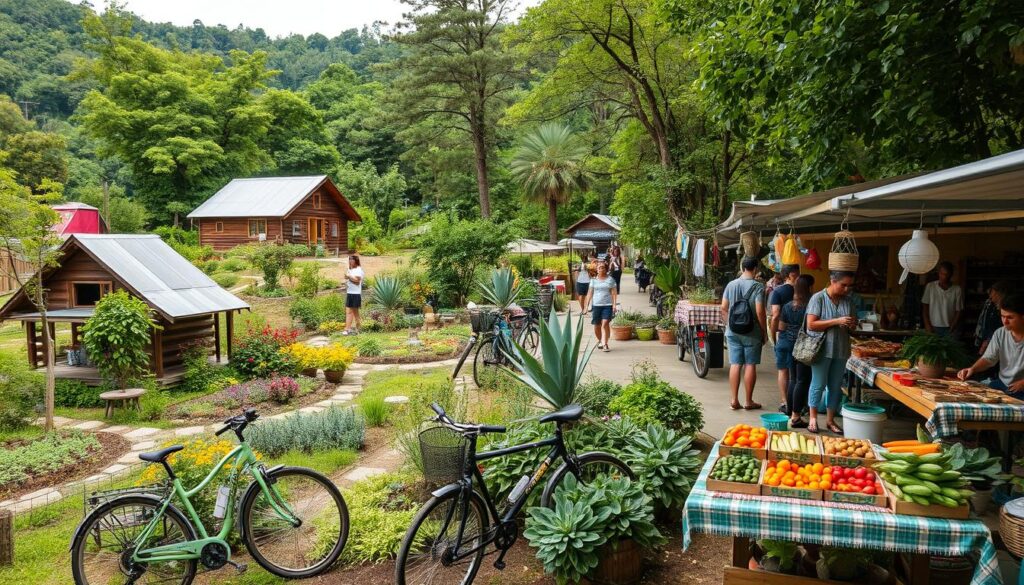
To tackle these issues, permaculture sites can start interactive educational programs. These programs boost visitor engagement by 30% and return rates by 40%. By focusing on sustainable travel, permaculture tourism can meet the demand for eco-friendly travel and help ecosystems thrive.
Case Studies in Permaculture Tourism
Permaculture tourism has been a hit, offering green travel and regenerative tourism activities. For instance, Quinta do Vale da Lama (QVDL) in Portugal started in 2014. It teaches sustainability and regenerative farming to 50 people. It also has a three-month volunteer program.
The Fall Farm Crawl in Southern Illinois showed off local farms and farming ways. It showed how agritourism can help the rural economy. These examples show how permaculture tourism helps local places and people, offering lessons for the future.
Successful permaculture tourism has a few key things:
- It focuses on sustainability and regenerative practices.
- It involves the community and lets them participate.
- It has education and awareness programs.
- It supports local economies and rural growth.
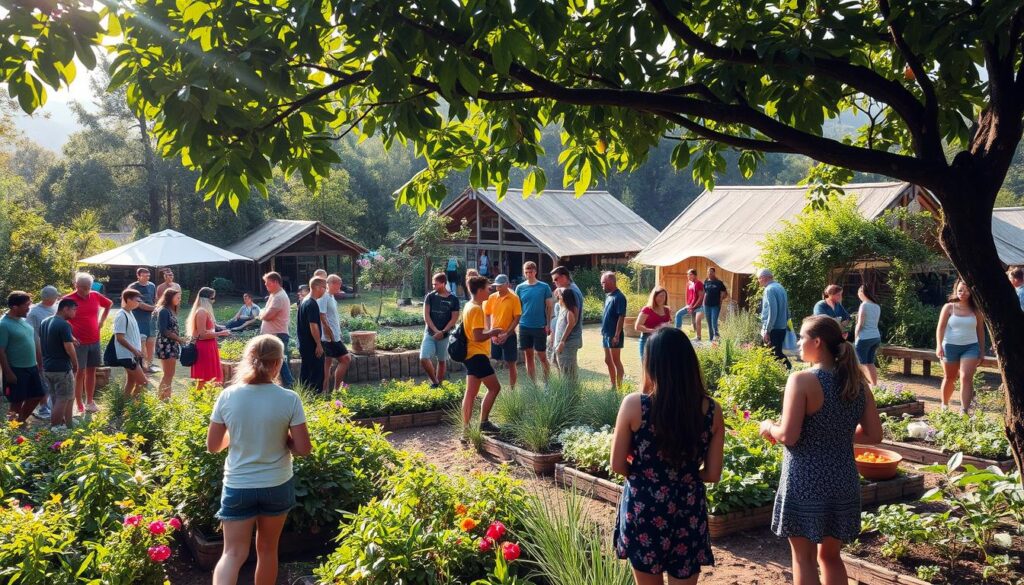
Looking at these examples, we can learn what works in permaculture tourism. It helps the environment, builds communities, and grows sustainable tourism.
| Initiative | Location | Key Features |
|---|---|---|
| Quinta do Vale da Lama | Portugal | Sustainability and regenerative farming programs |
| Fall Farm Crawl | Southern Illinois | Showcasing local farms and agricultural methods |
Future of Permaculture in Tourism
Permaculture is set to become a big part of tourism’s future. It focuses on saving the environment and making things better. Environmental education trips are getting more popular. People want to learn about living green and connect with nature.
New trends in permaculture tourism include growing food in a green way and staying in eco-friendly places. These changes will help the permaculture tourism grow. It will also make people more aware of traveling green.
- Enhanced educational experiences for travelers
- Increased support for local economies
- Promotion of environmental conservation and regeneration
As permaculture tourism grows, we’ll see even more green travel options. It’s all about learning and helping communities. Permaculture is leading the way in green tourism, offering unique experiences and helping the planet.
Conclusion
As we wrap up our talk on permaculture tourism, it’s key to stress its importance. Permaculture tourist activities help make tourism both sustainable and regenerative. By choosing eco-friendly tours, travelers help the environment and get to enjoy special, educational experiences.
Visiting sustainable farms, joining workshops on regenerative practices, and staying in eco-friendly places are some examples. These activities raise awareness about the environment and support local economies. For example, visitors can learn about permaculture’s role in animal welfare and sustainable farming.
Here are some key points about permaculture tourism:
- Supports local economies and communities
- Promotes environmental conservation and awareness
- Provides unique and educational experiences for travelers
- Contributes to the development of sustainable and regenerative tourism practices
In summary, permaculture tourism is a complete and sustainable way to travel. It helps the environment, supports local economies, and offers travelers unique experiences. As more people look for eco-friendly tours and permaculture tourist activities, the tourism industry must embrace and promote these practices.
| Benefits of Permaculture Tourism | Description |
|---|---|
| Environmental Conservation | Promotes sustainable and regenerative practices, reducing environmental impact |
| Supports Local Economies | Contributes to the development of local economies and communities |
| Unique Experiences | Provides educational and engaging experiences for travelers |
Call to Action
As we wrap up our exploration of permaculture tourism, it’s time to act. By joining sustainable travel experiences, like organic farming excursions, you help the tourism industry grow greener. This way, we all contribute to a better future.
Getting Involved
There are many ways to dive into permaculture tourism. You can volunteer at local farms or stay in eco-friendly places. You can also join permaculture action days in over 51 cities across the U.S. These events bring thousands together to make a real difference.
Making a Difference
Every choice we make matters, especially when traveling. By picking sustainable travel experiences and backing local projects, you help spread the word about
Here are some ways to make a positive impact:
- Support local farmers and choose organic food.
- Take part in permaculture workshops and courses.
- Volunteer at local permaculture projects.
Remember, every small step adds up. Together, we can build a greener, more sustainable tourism world.
Resources for Further Learning
Starting your journey in green travel opportunities and regenerative tourism activities is exciting. There are many resources to help you learn more. This section offers a wealth of information to guide you.
Books and Articles
There are many books and articles to explore. They cover topics like permaculture and sustainable tourism. Check out “Permaculture: A Designer’s Manual” by Bill Mollison and “The Permaculture City” by Toby Hemenway.
Also, read the “Journal of Sustainable Tourism” for a broad view. It’s a great way to stay informed.
Online Courses and Workshops
Online courses and workshops are key to keeping up with new developments. Midwest Permaculture offers Permaculture Design Certificate (PDC) courses. They have live virtual sessions and in-person workshops.
These programs teach you practical skills. They also help you connect with others who share your interests. It’s a great way to learn and get inspired.

